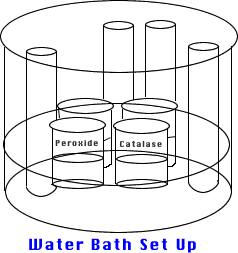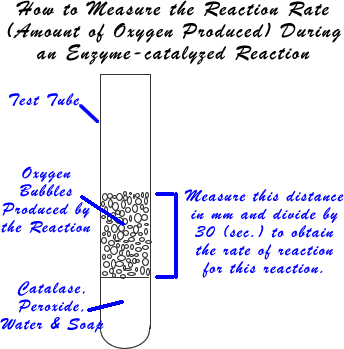 3.
Label one 80 ml beaker as "Catalase" and place 25 ml of catalase in
the beaker. Label one dropper as catalase with tape and place it in this beaker.
Always be sure to place this dropper in this beaker to avoid contamination.
3.
Label one 80 ml beaker as "Catalase" and place 25 ml of catalase in
the beaker. Label one dropper as catalase with tape and place it in this beaker.
Always be sure to place this dropper in this beaker to avoid contamination.
Example #1: How Temperature Affects the Rate of Enzyme Reactions.
1. Obtain all materials needed from the materials list.
2. Rinse all test tubes, beakers, and eye droppers out with soapy water and the test tube brush. Rinse several times with clean water & then carefully dry them inside & out with paper towel.
 3.
Label one 80 ml beaker as "Catalase" and place 25 ml of catalase in
the beaker. Label one dropper as catalase with tape and place it in this beaker.
Always be sure to place this dropper in this beaker to avoid contamination.
3.
Label one 80 ml beaker as "Catalase" and place 25 ml of catalase in
the beaker. Label one dropper as catalase with tape and place it in this beaker.
Always be sure to place this dropper in this beaker to avoid contamination.
4. Label a second 80 ml beaker as "Soap" and place some soap in this beaker. Label a second dropper as soap and place it in this beaker.
5. Label a third 80 ml beaker as "Hydrogen peroxide" and place 25 ml of peroxide in the beaker. Label a third dropper as peroxide and place it in the beaker.
6. Label a fourth 80 ml beaker as "Water" and place 25 ml of water in it. Label a fourth dropper as water and place it in the beaker.
7. Collect 150 ml of ice water in a 400 ml beaker. This will be a water bath to cool all ingredients to the desired temperature.
8. Place each of the 80 ml beakers (water, catalase, peroxide and soap) in the water bath. Be sure that they don't tip over to become contaminated! (See diagram at right.)
9. Place 4 clean, empty test tubes in the water bath too.
10. After 10 minutes, insert the thermometer into the catalase beaker in the water bath. If its contents have reached the desired temperature (under 5¾C), record this temperature in the data table.
11. Immediately place 5 drops of soap and 5 drops of catalase into 3 of the cooled test tubes & place them back into the water bath.
 12.
Measure 1 ml of peroxide with the graduated cylinder and pour it into the first
test tube. A reaction will occur. Wait for 30 seconds, then measure the foam
or bubbles produced. Measure from the bottom of the foam to the top of the foam,
using mm as the units (See diagram at right.) Record this data in the data table.
12.
Measure 1 ml of peroxide with the graduated cylinder and pour it into the first
test tube. A reaction will occur. Wait for 30 seconds, then measure the foam
or bubbles produced. Measure from the bottom of the foam to the top of the foam,
using mm as the units (See diagram at right.) Record this data in the data table.
13. Wash this test tube thoroughly.
14. Repeat steps 12 & 13 with the remaining 2 test tubes.
15. Place 5 drops of soap and 5 drops of cold water into the fourth test tube. Measure 1 ml of peroxide and pour into this test tube. No reaction should occur. This is the negative control. If a reaction has occurred, an error in the procedure has occurred, or the test tubes may be dirty.
16. Obtain 150 ml of room temperature water with the 400 ml beaker. Repeat steps 8-15 with this set up.
17. Obtain both room temperature and warm water. Mix them to produce 150 ml of water at about 35¾C. Hopefully this will produce water near body temperature. Repeat steps 8-15 with this set up.
18. Obtain hot water (near boiling). Use the heating pad if necessary to handle the hot water. Repeat steps 8-15 with this set up.
19. When finished, wash all materials and return them to their proper place. Discard all materials in the sink to avoid contamination of the provided samples.
20. Calculate the average amount of foam produced by each of the 3 trials for each temperature. This is done by adding the 3 trials and then dividing by 3. Record in the data table.
21. Calculate the rate of reaction by multiplying the average amount of foam produced at each temperature by 2. Since the measurements of foam were taken after 30 seconds, multiplying by 2 gives us the average reaction rate per minute. Record this in the data table.
21. Plot the average reaction rate vs. the temperature on a piece of graph paper.